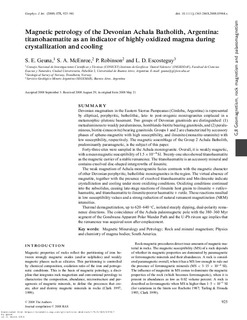Magnetic petrology of the Devonian Achala Batholith, Argentina: titanohaematite as an indicator of highly oxidized magma during crystallization and cooling
Journal article, Peer reviewed
Published version
Permanent lenke
http://hdl.handle.net/11250/2491943Utgivelsesdato
2008Metadata
Vis full innførselSamlinger
Originalversjon
Geophysical Journal International. 2008, 175 (3), 925-941. 10.1111/j.1365-246X.2008.03964.xSammendrag
Devonian magmatism in the Eastern Sierras Pampeanas (Córdoba, Argentina) is represented by elliptical, porphyritic, batholithic, late- to post-orogenic monzogranites emplaced in a metamorphic—plutonic basement. Two groups of Devonian granitoids are distinguished: (1) metaaluminous to weakly peraluminous, hornblende-biotite bearing granitoids, and (2) peraluminous, biotite-(muscovite) bearing granitoids. Groups 1 and 2 are characterized by accessory phases of sphene-magnetite with high susceptibility, and ilmenite-(monazite-uraninite) with low susceptibility, respectively. The magnetic assemblage of the Group 2 Achala Batholith, predominantly paramagnetic, is the subject of this paper.
Forty-three sites were sampled in the Achala monzogranite. Overall, it is weakly magnetic, with a mean magnetic susceptibility of 1.5 × 10−4 SI. Twenty-one sites showed titanohaematite as the magnetic carrier of a stable remanence. The titanohaematite is an accessory mineral and contains exsolved disc-shaped intergrowths of ilmenite.
The weak magnetism of Achala monzogranite facies contrasts with the magnetic character of other Devonian porphyritic, batholithic monzogranites in the region. The virtual absence of magnetite, together with the presence of exsolved titanohaematite and Mn-ilmenite indicate crystallization and cooling under more oxidizing conditions. Oxidizing conditions continued into the subsolidus, causing late-stage reactions of ilmenite host grains to ilmenite + rutile+ haematite, and titanohaematite to ilmenite-poorer haematite + rutile. These reactions resulted in low susceptibility values and a strong reduction of natural remanent magnetization (NRM) intensities.
Thermal demagnetization, up to 620–640 °C, isolated steeply dipping, dual-polarity remanence directions. The coincidence of the Achala paleomagnetic pole with the 380–360 Myr segment of the Gondwana Apparent Polar Wander Path and the U-Pb zircon age implies that the remanence was acquired soon after emplacement.
